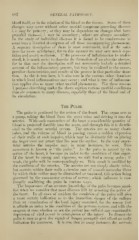Page 652 - My FlipBook
P. 652
6(32 GENERAL PATHOLOGY. —
blood itself, or in the relation of the blood to the tissues. Some of these
changes may occur without other morbid symptoms preceding them
i. c. may be primary ; or they may be dei^endent on changes that have
preceded them— /, e. may be secondary ; others are always secondary.
In the study of individual diseases it is found to be cumbersome to
enter into a detailed description of all these accompanying phenomena.
A separate description of them is most convenient, and at the same
time far more satisfactory, for in this manner we may save much repe-
tition and avoid confusion. If the processes of inflammation be under-
stood, it is much easier to describe the formation of an alveolar abscess,
for in that case the description will not necessarily include a detailed
account of the inflammatory process, but may be confined to the causes,
peculiar characteristics, and results of the process in that particular situa-
tion. As this is true here, it is also true in the various other situations
in which local inflammations may occur ; and what is true of inflamma-
tion applies also to many other morbid phenomena. For these reasons
I purpose describing under the above caption various morbid conditions
that are common to many diseases, especially those of the blood and of
its circulation.
The Pulse.
The pulse is produced by the action of the heart. This organ acts as
a pump, taking the blood from the great veins and driving it into the
arteries. With each contraction of the Iieart a considerable quantity of
blood is projected forcibly into the aorta, and through this it is distrib-
uted to the entire arterial system. The arteries are so many elastic
tubes, and the volume of blood in passing causes a sudden expansion
of their walls at each impulse, which may be distinctly felt on placing
the finger over any artery that lies near the surface. In the very super-
ficial arteries tlie impulse may, in many instances, be seen. This
movement- is known as " the pulse." As the pulse is caused by the
action of the heart, it becomes an index to the condition of that organ.
If the heart be strong and vigorous, we will find a strong pulse ; if
weak, the ])nlse \vill be correspondingly so. Tliis result is modified by
the condition of the arteries. The arteries are not simply elastic tubes,
but contain within their walls a circular coat of smooth muscular fibres
by which their calibre may be diminished or increased, this action being
governed by the vaso-motor system of nerves ; which influence is con-
tinually modifying the pulse in various ways.
The importance of an accurate knowledge of the pulse becomes mani-
fest when we consider that most diseases kill by arresting the action of
the heart. In all cases of accident the condition of the pulse will give
a more certain indication as to the immediate danger of the sufferer
than an examination of the local injury sustained, for the reason that
it affords an index to the condition of the nervous system, and tells the
surgeon at once whether or not the patient has suffered anv considerable
depression of vital power in cons-equence of the injury. In disease the
])ulse is sure to give the signal of danger promptly and afford an early
indication for treatment. It is true that in manv instances the nervous


